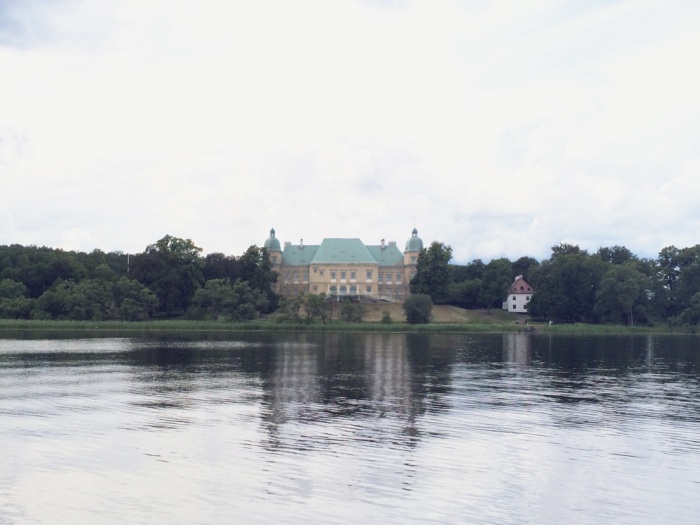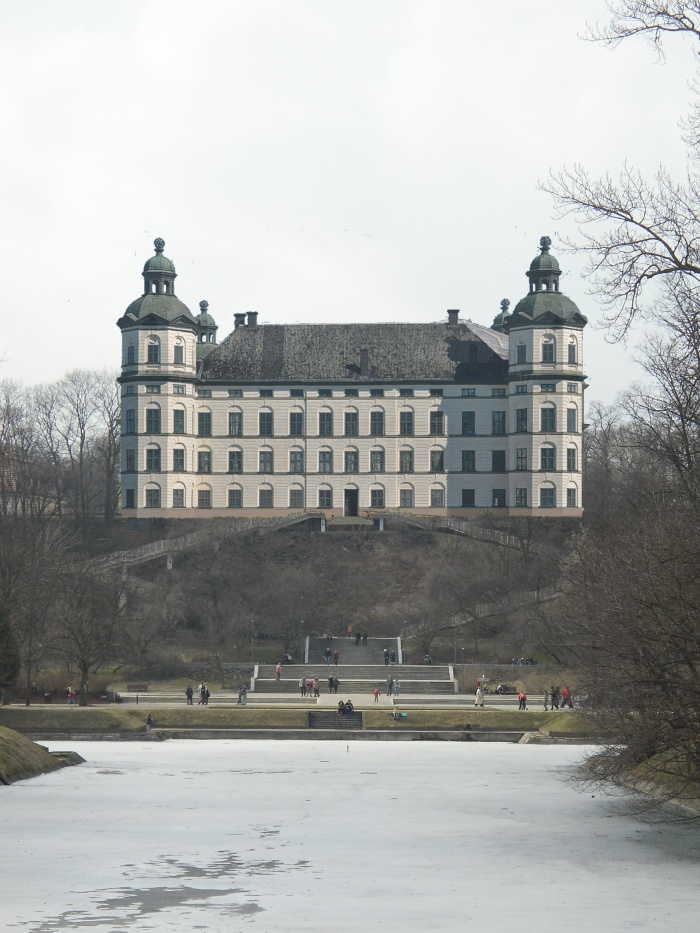
Zamek Ujazdowski z odbiciem sylwetki zamku Skokloster na tafli wody. Autor: Vitalij Strigunkow, 2017. Dzięki uprzejmości artysty.
In Scandinavian folklore there is an entity called a Vardøger. It resembles a more famous uncanny double, the Doppelgänger, but with a certain small difference: a Vardøger is a spirit – or rather a tangible presence – that appears just before the arrival of that same person. One may hear their voice or footsteps, which gives us an impression that someone is already there.
The Ujazdowski Castle in Warsaw has its double in Sweden – the baroque Skokloster castle at Malaren lake, between Stockholm and Uppsala. These two edifices share not only their outer form, but also coincidental similarities in history, despite living seemingly different lives. The Warsaw castle has changed its function many times (and along with that, its form), until it was demolished and rebuilt in the postwar era. Its Swedish “twin” has survived for centuries unharmed. Still, both buildings share certain experiences: abandoned construction halfway through, reconstruction in the spirit of historical accuracy, culminating in their current function as institutions of culture (even though their content differs significantly). During these phases of existence, sometimes one of the castles, and sometimes the other one, took on the role of a Vardøger.
When we look at each of the castles in turn, we see a nearly cloned layout of a four-wing residence with a courtyard inside and hexagonal towers in the corners; the Skokloster castle is more massive, taller. According to a popular explanation (it’s not certain to what extent legendary), during the Swedish invasion of Poland the building, designed by Tylman van Gameren, amazed field marshal Carl Gustaf Wrangel. The outstanding military leader, equally famous for his passion as a collector and lavish, dandy lifestyle, hired architect Caspar Vogel to create a similar castle on the other side of the Baltic Sea. Aside from serving as an idea for the field marshal’s new residence (probably), the Swedes had (certainly) carried away paintings and books from the Ujazdowski Castle’s library, as part of their significant war loot – some of which is still to be found in the Vistula river. It’s not certain to what extent treasures from the Ujazdowski Castle ended up in Skokloster, but after the purchase of the castle at Malaren by the Swedish state, a large body of Polish literature was found. The collection of “polonica,” (Poland-related objects) which now belonged to the repository of the museum, is a subject of interest for researchers from Poland and Sweden alike. It’s not an obvious kind of treasure, for a large part of it consists of literature which could be described today as vernacular, or semi-professional. This valuable collection documents the “small history” of the Sarmatian era: diaries, silvae rerum, letters, vernacular commemorative poetry, wedding speeches, epitaphs or rousing speeches (the equivalent of “motivational coaching” of that period) which serve as proof of the creative pursuits of the Polish gentry.
Even before the partition of Poland era, the Ujazdowski Castle changed its owners often: from the Lubomirski family, through king Augustus II the Strong, to king Stanisław August Poniatowski, who intended to rebuild the castle as his private residence. Eventually, he abandoned these plans and donated the building to the army; from that moment on, the Castle began to lose its original character, and its Baroque shape was gradually disappearing under various extensions, added at first so that it could be used as a military barracks, and then, as a hospital. Abandonment and temporary hibernation became Skokloster’s share of fate, too: after Wrangel’s death, the unfinished object became the property of the Brahe family, who continued the development slowly. The banquet room, the largest in Europe, has been left incomplete up to the present day. The building began to serve a joint function – a family residence and a heritage museum, enjoying the interest of visitors. Eventually, the latter function became the main one.
Colossal enterprises – unfinished, requiring renovation, reconstructed castles and palaces sometimes prove to outgrow the renovators’ ambitions. Once the walls and roofs are repaired, vast spaces inside reveal themselves, demanding management. In the case of ruins, the work is performed by the imagination, which complements a picturesque scenery with speculative scripts; the ruin functions as a catalyst, it encourages us. In a reconstructed space, naked rooms urge: do something about us. So, something is being done, we know this from many old/new monumental buildings countrywide: film sets, atmospheric business conferences and family events, medieval fairs, knights’ tournaments, restaurants and bars with hot mead; sometimes, a local or a private museum, thematically unrelated to the host premises, usually resembling a low-key, sympathetic wunderkammer built from artifacts provided by conscious locals, hiking clubs, or geology societies, that donate deposits from ammonites and pieces of basalt to folk kitchen rugs, and school ID cards. Before Skokloster was purchased by the Swedish state, its owners opened the castle to visitors. Part of the spaces were preserved in their historical form, while the rest became home to an automobile museum, which still exists and enjoys popularity in its new location in Simrishamn.
While Swedish automobile enthusiasts were admiring the collection stored at the field marshal’s residence, the Ujazdowski Castle experienced a hiatus in its very existence. Despite surviving World War II in a condition allowing for reconstruction, the military decided to take down the walls, leaving only basements – today, the only authentic element of the building – and certain facilities of the old hospital. The space left after the Castle was supposed to have been arranged in a fitting spirit to the new era, and many new purposes were considered: House of the Polish People’s Army, House of the People, maybe even new headquarters for the head of state. In the meantime, teenagers hang out in the park and go to sports practice on the premises. The area remains in limbo. In the 1970s, decisions to rebuild the Royal Castle and to establish the Łazienkowska Thoroughfare kickstart other reconstructions in Warsaw – including one regarding the rebuilding of the Ujazdowski Castle, under the supervision of Piotr Biegański. The work has begun – yet still without a clear decision concerning the building’s future purpose.
While a decision to reconstruct the Ujazdowski Castle is being made in Warsaw, Skokloster is being turned into a state museum. The “new-authentic” shape of the Warsaw castle refers to the Vasas’ residence from the 17th century. The Baroque version was considered the best and most worthy of preservation – hence the later extensions from the military and hospital periods of the building’s existence were omitted. The interiors were arranged in a Stanisław August Poniatowski-era style; stairs and portals leading to particular rooms were made from materials sourced from the Mazowsze region. The renovation of the castle at Lake Malaren has followed similar principles, though it’s not known whether architects on both sides of the Baltic Sea were aware of these parallel pursuits. Architect Ove Hidemark decided to use not only materials, but also technologies from the period in which the castle was built, using textbooks found in Wrangel’s library.

Sylwetka zamku Skokloster stojąca w miejscu Zamku Ujazdowskiego. Widok z Kanału Piaseczyńskiego. Autor: Vitalij Strigunkow, 2017. Dzięki uprzejmości artysty.
Before the Ujazdowski Castle became home to the Centre for Contemporary Art, various scenarios were considered for its potential purpose. According to early rumors, it was supposed to be the new headquarters of Comecon, later – a hotel for officials; the floor occupied now by offices was designed for guest rooms first. While still in the 1980s, it was eventually announced that the Castle will be used for culture and art; yet for most of the decade was spent on apparently simulated activities that served no actual purpose. The first director of the Centre, Wojciech Krukowski, mentioned in his memoirs how surprised he was to discover numerous micro-companies which had managed to multiply in the noble interiors, producing fashionable garden balusters for the emerging business class.
Locating the Centre for Contemporary Art in a “new-old” Baroque castle was a non-obvious and bold move, which matched the overall history of the place, full of unexpected turns. This “nonapparent monument,” “a 17th-century building, built 300 years later,” as Anna Cymer called it, is a layered construction in which the past regularly keeps coming back up to the surface. The renovation of the basements unexpectedly brought back to life the remains of an old moat, paving the yard led to the rediscovery of a 17th-century garden irrigation system. Unearthing a well that reached to the surface level of the Vistula river allowed, not only for the rediscovery of hospital equipment which had been left there since the war, but also much newer documents of microhistory – pieces of paper with horrifying confessions made by the kids of Warsaw, who had to get it off their chests – such as “when dad asked me to buy a newspaper, I pretended to be busy with my homework.” Meanwhile, the Skokloster museum, while serving as an institution of culture as well, remains much more conservative. A visit to this typical museum reconstructing aristocratic homes is resemblant more of a visit to the palace in Pszczyna or Niepołomice, maybe to an extent the interiors at the Wawel castle. Skokloster boasts a painting by Arcimboldo, an arsenal, and Wrangel’s wunderkammer, full not only of war loot, but also of memorabilia from his travels to other continents. Today, the castle hosts costume events and knights’ tournaments, encouraging visitors to take a “Baroque selfie.”
The postwar reconstruction of the Ujazdowski Castle turned the time back in a certain sense. A decision to recover the 17th-century shape brought out the similarities it shares with its Swedish equivalent. Enthusiasts of mysteries and paranormal tales believe in telepathic connections between twins; when we follow the fates of both castles, Ujazdowski and Skokloster, one may get the impression that this phenomenon may also be true of architecture, and that there may be subtle threads which appear to link together buildings located miles away from each other.
Translated from Polish by the Author
BIO
Olga Drenda is an ethnographer/anthropologist, author, and translator. She has published in 2+3 D, Slanted, Znak, Dwutygodnik, Nowy Obywatel et al., and has collaborated with Unsound Festival, Centre for the Meeting of Cultures in Lublin, and many others. She is the author of the Duchologia Polska page (facebook.com/duchologia) and the books Duchologia polska. Rzeczy i ludzie w latach transformacji (Karakter 2016), Czyje jest nasze życie (together with Bartłomiej Dobroczyński, Znak, 2017). Her interests include the anthropology of daily life, the transformation era in Poland and Central-Eastern Europe, and the subcultures of amateur creatives and collectors. She lives in Mikołów.
* Cover photo: Ujazdowski Castle and Skokloster Castle's reflection on the water. Author: Vitalij Strigunkov, 2017. Courtesy of the artist



